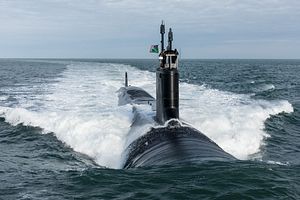The U.S. Navy’s newest Virginia-class nuclear attack submarine USS Washington (SSN-787) successfully completed initial sea trials off the coast of Virginia at the beginning of this month, according to an April 3 Newport News Shipbuilding statement.
“All systems, components, and compartments were tested during the trials,” the written statement said. “The submarine submerged for the first time and operated at high speeds on the surface and underwater.”
The boat, built as part of a teaming agreement between Huntington Ingalls Industries’ Newport News Shipbuilding division and General Dynamics Electric Boat, will now move on to acceptance trials before delivery to the U.S Navy. The USS Washington is expected to be commissioned in the summer of 2017.
“The ship and its crew performed exceptionally well,” a senior executive of Newport News said, according to the statement. “It was truly an amazing process to see the hundreds of suppliers and the many thousands of shipbuilders from both Newport News and Electric Boat work closely with the ship’s crew to bring this great warship to life.”
The U.S. Navy is planning to acquire up to 51 Virginia-class subs.
Virginia-class boats are built in block increments, with Block I and Block II already delivered to the U.S. Navy. In total, the U.S. Nay will receive eight Block III Virginia-class SSNs. The Washington will be the fourth Block III boat featuring the new Virginia Payload Modules (VPM) – larger tubes that increase the ship’s missile-firing payload possibilities (See: “US Subs Getting Fire Power Boost”).
While the first 10 Block I and Block II Virginia-class submarines feature 12 individual 21-inch diameter vertical launch tubes able to fire Tomahawk Land Attack Missiles (TLAMS), “the Block III submarines are built with two-larger 87-inch diameter tubes able to house six TLAMS each,” according to the U.S. Navy website. The new 87-inch tubes have been designed to accommodate future missile systems in addition to the Tomahawk.
In addition, Virginia-class Block III boats are equipped with four torpedo tubes for MK48 torpedoes. Furthermore, next to a redesigned bow, Block III Virginia-class boats also contain “a water-backed Large Aperture Bow (LAB) sonar array that replaces the air-backed sonar sphere found in the first 10 Virginias.” This, in combination with the its so-called fly-by-wire capability, enables the boat to perform important intelligence and surveillance missions.
The new boats are multipurpose platforms and designed “to fulfill the seven core competencies of the U.S. Navy’s submarine force: anti-submarine warfare; anti-surface warfare; delivery of special operations forces; strike warfare; irregular warfare; intelligence, surveillance and reconnaissance; and mine warfare,” I reported elsewhere.
U.S. Navy official consistently point out that the service faces a shortage of boats, especially in the Asia-Pacific region and there are plans to accelerate construction of Virginia-class SSNs.

































